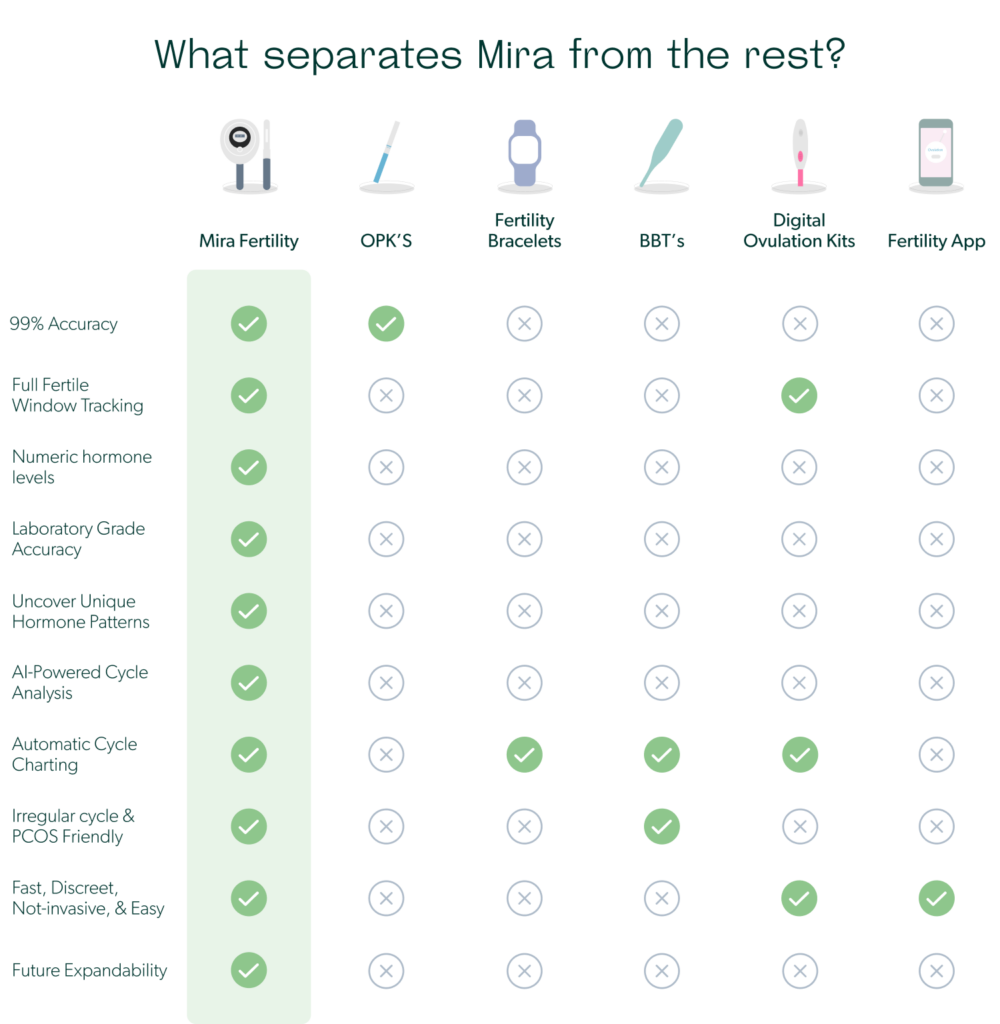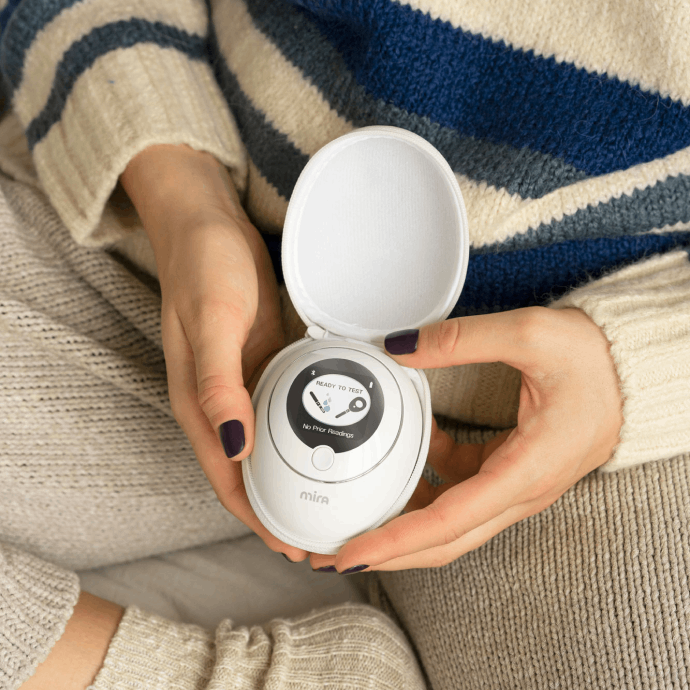Choosing the Best Fertility Monitor: Why more and more people trust Mira
With dozens of different fertility monitors available, finding one that suits your lifestyle and individual situation can feel so overwhelming!

To help, we’ve put together an overview covering the most common types of fertility monitors, how they work, and considerations to make before purchasing. We’ve also shared some information about our own fertility monitor, the Mira Hormone Monitor, and what sets its technology apart from the rest!
Ready? Let’s go!
What is a fertility monitor?
Fertility monitors are digital devices that track data about your menstrual cycle. They are primarily used to predict ovulation and identify an individual’s most fertile days. This information can then be used to plan (or avoid) a pregnancy.
How do fertility monitors work?
The body undergoes many changes throughout the menstrual cycle, and these changes are reflected in things like our temperature, saliva, cervical mucus, and urine. By keeping a close eye on these biological markers, it is possible to predict and confirm ovulation with up to 99% accuracy in some cases, depending on the individual and the tracking method.
For example, basal body temperature (BBT) is known to drop slightly prior to ovulation before quickly increasing after ovulation. Cervical mucus also changes in the days leading up to ovulation, becoming noticeably clearer in color and slippery in texture. Certain hormones are also released throughout the body around ovulation and the metabolized form of these hormones can be detected in urine.
In short, fertility monitors are designed to help people keep track of these biological symptoms over time. In doing so, individuals can more accurately anticipate their fertile window in order to stay in tune with their reproductive health and fertility status.
Types of fertility monitors
BBT Thermometers
Basal Body Temperature (BBT) thermometers are a special type of thermometer that can measure slight changes in body temperature when it is completely at rest. The most basic type of BBT thermometers simply measure and display a temperature so that you can easily record it in a diary or on your calendar. More advanced BBT thermometers can sync with an App and provide you with detailed charts and reports about your cycle.
Armbands
Another way to measure your body’s BBT is with an armband device. This type of fertility monitor is typically worn while you are sleeping, and it has multiple sensors that continuously measure your BBT. Your BBT data is then synced and stored on the device’s corresponding app, where it can be used to chart your fertility status.
Vaginal devices
There are two different types of vaginal devices that can be used to track ovulation. The first type monitors electrolyte levels in cervical mucus, and the second type measures Core Body Temperature (CBT) using a thermistor. Like most fertility monitors, vaginal devices typically have a corresponding app that can help you with charting and interpreting your results.
Hormone monitors
Hormone monitors, like the Mira Hormone Monitor, are typically small, handheld devices that can be used to measure hormone levels in urine or saliva. They are used in conjunction with testing wands (similar to pregnancy tests and ovulation predictor kits (OPKs)), and the results can be synced with an app where an individual’s quantitative hormone levels, along with other cycle data, can be monitored and tracked over time.
Choosing the right fertility monitor for you
Lifestyle and schedule
Many fertility monitors require you to measure or test at a specific time each day. If you have an irregular schedule, for example maybe you work night shifts, this type of monitor may not be the best choice. Instead, look into armbands that measure BBT continuously while you’re sleeping. Or, Mira’s urine tests can be taken any time of day – as long as fluid intake has been limited for at least two hours prior to testing.
Cycle characteristics and medical history
If your cycles are longer/shorter than average, irregular, and/or you have a hormonal condition such as polycystic ovarian syndrome (PCOS), you will want to make sure to choose a fertility monitor that is compatible with your body and cycle patterns. If you’re unsure about how to evaluate your options given your medical history, speak with your doctor and they can help you make the best decision for your individual situation.
Accuracy and detail
Fertility monitors vary greatly in terms of what types of data can be tracked, how that data is stored, and how accurate it is at charting and predicting your fertile days.
Before making a decision, it’s worth taking a moment to consider what your expectations are for your device in terms of accuracy and detail, and then choose a device that meets those expectations.
Over 84,000 people all over the world have chosen the Mira Hormone Monitor to support their fertility journeys.
Why choose Mira?
Mira is the only at-home fertility monitoring system that uses quantitative technology to track key fertility hormone levels in urine. This includes:
- Luteinizing hormone (LH) to pinpoint ovulation
- Estrone-3-glucuronide (E3G) to predict 6-days fertile window
- Pregnanediol glucuronide (PdG) to confirm ovulation
- Follicle-stimulating hormone (FSH) to understand your fertility status

Mira’s Accuracy rivals professional lab equipment: you can rely on Mira’s results. Mira Hormone Monitor provides proven accurate and highly precise results with minimal variation, confirmed through comparison with the Abbott ARCHITECT i2000SR.
Shortly: with Mira, you get lab-grade numeric hormone testing to the comfort of your bathroom – without any pricking, travel time, or thousands in medical bills.
How Mira’s Technology is different?
Mira’s technology is based on high-precision professional fluorescent detection – practically the same technology that is used in the real labs, but placed inside of a tiny, palm-sized reader. This is what enables Mira to provide individuals with their real-time, numeric urinary hormone level results.
For context, other hormone-based fertility monitors are typically built on a traditional OPK technology (i.e. nano-gold labeled lateral flow assay) – meaning they simply digitize shades of a test line using a smartphone camera.

❓ Why using a smartphone camera to read hormone tests may not be the best solution?
Simply saying: your camera is not optimized, not calibrated, and not validated to ensure consistent and precise measurements. Fluorescent analyzers (like the one used by Mira) are scientifically considered superior to the cameras of consumer mobile phones for reading lateral flow immunoassays.
Mira’s technology provides a higher level of sensitivity and broader hormone range than traditional nano-gold labeled lateral flow solutions. It means that Mira can pick up on the smallest hormonal changes in your body, and even if your hormones are higher than basic levels, Mira still may detect them. That can be especially important for individuals with irregular cycles or PCOS.

The Power of AI
Over 84,000 people have chosen the Mira analyzer, and this wealth of data has elevated Mira’s AI capabilities to new heights. In fact, Mira is trained and optimized on over 10 million hormone data points, which helps to provide users with more advanced predictions about their cycle.
Cycle App giants also have a large amount of cycle data. However, they only have basic period data and not specific hormone level data. Other fertility monitors on the market also have limitations – for example, they are often:
- Not quantitative
- Not connected to AI or
- They have significantly fewer data points to pull from when making cycle predictions.
Mira’s accuracy is so well-proven that healthcare professionals, including fertility clinics and OB/GYNs, choose to utilize the Mira monitor and integrate it into their practice to improve patient experience. We’ve also been selected for multiple research studies by Mount Sinai, the University of Melbourne, the University of British Columbia, Uppsala University (Sweden), University Hospital Zurich, Johns Hopkins University, and dozens of other institutions.

More than just conception
Our mission is not just to help people conceive, but it’s about helping individuals and families form new health habits. We want using Mira to be as easy as brushing your teeth, and we want to help you better understand how your hormones work and how hormonal fluctuations can impact your well-being.
This is why we’ve recently launched a study that delves deeper into how hormones affect mood, sex drive, and various other areas of well-being. We’ve also recently collaborated with Athletica.ai and HRV4Training to conduct a study on how the menstrual cycle impacts athletic training performance.

Final Thoughts
Whether you choose to monitor your fertility using an armband, thermometer, or digital monitor like Mira, we are on your side and we’re excited that you’re learning more about your body!
If you’re looking for further information about reproductive health and fertility, we welcome you to check out our library of blog articles, eBooks, and Facebook support group.
Mira’s Editorial Process
All content produced by Mira meets stringent editorial standards, ensuring excellence and accuracy in language and medical precision. Every piece undergoes thorough fact-checking and review by qualified professionals. Check out our full editorial process to learn more.










